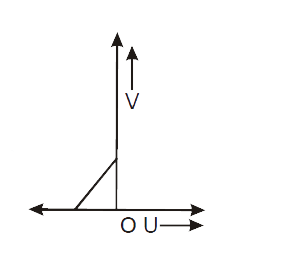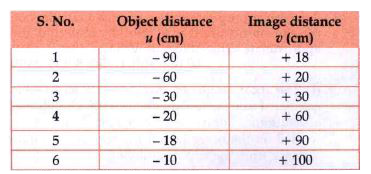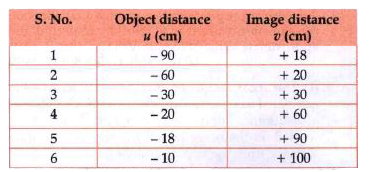Analyse the following observation table showing variation of image distance (v) with object distance (u) in case of a convex lens and answer the questions that follow, without doing any calculation :

What is the focal length of the convex lens ? Give reason to justify your answer.
The focal length of the convex lens can be calculated from S.No. 3 as when an object is placed at a distance from the convex lens its image is formed on the other side of the lens at the same distance from the lens. So, the radius of curvature is 40 cm. Thus, focal length is half the radius of curvature i.e., + 20 cm.
Similar Questions
Analyse the following observation table showing variation of image distance (v) with object distance (u) in case of a convex lens and answer the questions that follow, without doing any calculation :

What is the focal length of the convex lens? Give reason in support of your answer.
View SolutionAnalyse the following observation table showing variation of image distance (v) with object distance (u) in case of a convex lens and answer the questions that follow, without doing any calculation :

Write the serial number of the observation which is not correct. On what basis have arrived at this. conclusion ?
View Solution
Knowledge Check
The graph between the image distance (v ) and object distance (u) from the convex lens is
A B
B C
C D
D
The distance between the object and its real image from the convex lens is 60 cm and the height of image is two times the height of object . The focal length of the lens is
A203 cmB20 cmC403cmD40 cm
Analyse the following observation table showing variation of image distance (v) with object distance (u) in case of a convex lens and answer the questions that follow, without doing any calculation :

Write the serial number of that observation which is not correct. How did you arrive at this conclusion?
View SolutionAnalyse the following observation table showing variation of image distance (v) with object distance (u) in case of a convex lens and answer the questions that follow, without doing any calculation :

Select an appropriate scale and draw a ray diagram for the observation at S. No. 2. Also find the approximate value of magnification.
View SolutionAnalyse the following observation table showing variation of image distance (v) with object distance (u) in case of a convex lens and answer the questions that follow, without doing any calculation :

Take an appropriate scale to draw ray diagram for the observation at S. No. 4 and find the approximate value of magnification.
View SolutionAnalyse the following observation table showing variation of image-distance (v) with object-distance (u) in case of a convex lens and answer the questions that follow without doing any calculations :
S.No.Object-distanceImage-distanceu (cm)v (cm)1−100+252−60+303−40+404−30+605−25+1006−15+120
(a) What is the focal length of the convex lens ? Give reason to justify your answer.
(b) Write the seril number of the observation which is not correct. On what basis have you arrived at this conclusion ?
(c) Select an appropriate scale and draw a ray diagram for the observation at S.NO. 2. Also find the approximate value of magnification.
View SolutionThe graph in shows the variation of image distance (v) with object distance (u) in case of a lens. Find focal length of the lens. What is the nature of the lens, if image formed is real ?
 .
.
View SolutionDraw ray diagrams showing the image formation by a concave lens when an object is placed
(a) between focus and twice the focal length of the lens
(b) beyond twice the focal length of the lens
View Solution
